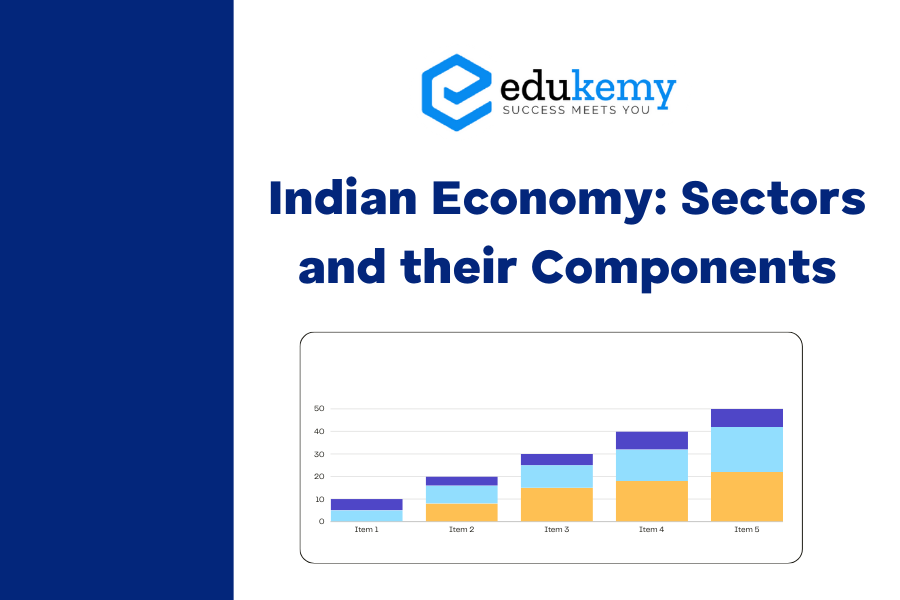
The division of the Indian economy into three sectors, along with their respective components, is a common way of categorizing and analyzing economic activities. This division provides insights into the structure and composition of the economy. Here’s a breakdown of the sectors and their components in the Indian economy:
- Agriculture, Forestry, and Fishing Sector:
- Crops: This includes the cultivation of various crops such as rice, wheat, sugarcane, cotton, and other agricultural products.
- Livestock: It covers activities related to raising and breeding livestock, including cattle, poultry, and other animals.
- Forestry and Logging: This sector involves activities related to forestry, logging, and the production of timber and other forest products.
- Fishing and Aquaculture: This component includes activities related to fishing in both inland and marine waters, as well as aquaculture or fish farming.
- Industry Sector:
- Mining and Quarrying: This component encompasses the extraction of minerals, ores, and other geological resources from the earth.
- Manufacturing: It includes the production of a wide range of goods, from food products and beverages to textiles, machinery, and equipment.
- Electricity, Gas, Water Supply, and Other Utility Services: This component covers the generation and distribution of electricity, gas, and the supply of water. It also includes other utility services.
- Construction: Activities related to building and construction projects, infrastructure development, and real estate construction are part of this component.
- Services Sector:
- Trade, Repair, Hotels, and Restaurants: This includes wholesale and retail trade, repair services, and the hospitality industry, including hotels and restaurants.
- Transport, Storage, Communication, and Services Related to Broadcasting: This component covers transportation (railways, road, water, and air), storage services, communication services, and broadcasting.
- Financial, Real Estate, and Professional Services: It encompasses financial services, real estate activities, and professional services such as legal, accounting, and consulting services.
- Community, Social, and Personal Services: This includes public administration, defense, and other social services.
- Other Services: Various other services, not classified in the above categories, are included in this component.
The division of the economy into these sectors helps in understanding the relative importance of different economic activities and their contributions to the overall GDP. It also allows policymakers and analysts to track changes in the structure of the economy over time.
As It mentioned, at 2011-12 prices, the agriculture and allied sector contributes approximately 15 percent to the Indian GDP, the industry sector contributes around 31 percent, and the services sector constitutes the majority at about 54 percent. These proportions can vary over time as the economy evolves and diversifies.
Contents
- 1 FAQs
- 1.1 Q: What are the key sectors of the Indian economy?
- 1.2 Q: What are the major components of the agricultural sector in India?
- 1.3 Q: What are the key industries driving the secondary sector in India?
- 1.4 Q: What are the components of the tertiary sector in the Indian economy?
- 1.5 Q: How does the service sector contribute to India’s economy?
- 2 In case you still have your doubts, contact us on 9811333901.
FAQs
Q: What are the key sectors of the Indian economy?
A: The Indian economy is broadly categorized into three main sectors: primary, secondary, and tertiary. The primary sector includes agriculture, forestry, fishing, and mining. The secondary sector comprises manufacturing, construction, and utilities. The tertiary sector encompasses services such as retail, healthcare, education, finance, and tourism.
Q: What are the major components of the agricultural sector in India?
A: The agricultural sector in India consists of various components including crops (both food grains and cash crops), livestock, forestry, and fisheries. Food grains like rice, wheat, and pulses are significant contributors, along with cash crops such as cotton, sugarcane, and oilseeds. Livestock farming involves dairy, poultry, and animal husbandry. Forestry includes logging and timber production, while fisheries involve both marine and inland fishing activities.
Q: What are the key industries driving the secondary sector in India?
A: The secondary sector in India is predominantly driven by manufacturing industries such as textiles, automobiles, chemicals, pharmaceuticals, electronics, machinery, and steel production. Construction also plays a vital role in this sector, including residential, commercial, and infrastructure projects. Utilities such as electricity, gas, and water supply further support industrial activities.
Q: What are the components of the tertiary sector in the Indian economy?
A: The tertiary sector in India comprises a diverse range of services. Major components include retail and wholesale trade, transportation and logistics, healthcare, education, banking and finance, telecommunications, hospitality, entertainment, and information technology (IT) services. Additionally, professional services like legal, accounting, consulting, and real estate contribute significantly to the tertiary sector’s growth.
Q: How does the service sector contribute to India’s economy?
A: The service sector is the largest contributor to India’s GDP and employment. It accounts for a significant portion of economic activity and plays a crucial role in driving growth and development. Services such as IT and IT-enabled services (ITES), business process outsourcing (BPO), software development, and telecommunications have propelled India’s reputation as a global outsourcing destination. Additionally, sectors like healthcare, education, tourism, and financial services contribute substantially to the economy, reflecting the sector’s diversity and importance.
In case you still have your doubts, contact us on 9811333901.
For UPSC Prelims Resources, Click here
For Daily Updates and Study Material:
Join our Telegram Channel – Edukemy for IAS
- 1. Learn through Videos – here
- 2. Be Exam Ready by Practicing Daily MCQs – here
- 3. Daily Newsletter – Get all your Current Affairs Covered – here
- 4. Mains Answer Writing Practice – here

